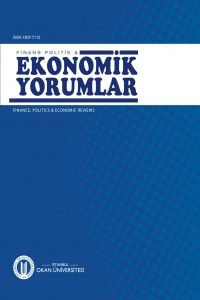Oyunlarda Öğrenme: İki Deney
İktisat bilimine deneysel yaklaşımlar son 40 yılda popülerliğini artırmış ve ampirik analizde önemli araçlardan biri haline gelmiştir. Davranışları matematiksel temellerde modellenen ajanların daima rasyonel davrandığı düşünülürken bu modellerin test edilmesi ve bireylerin farklı durumlarda aldığı kararların incelenebilmesi sağlanmıştır. Bu makalede, iki farklı ortamda yapılan deney ile bu durumu örneklendireceğiz. Braess paradoksu, günlük hayatta her bir bireyin karşılaştığı yol seçimi sorununu konu edinirken, Cournot oligipol modeli ise miktar rekabeti durumunda verilen üretim kararı üzerinden karar alma davranışını incelemektedir. Bu çalışma, rasyonel karar alma kabiliyetini farklı alanlarda eğitim alan öğrenciler üzerinden Braess paradoksu ve Cournot modeli dahilinde deneysel olarak incelemektedir
Anahtar Kelimeler:
rasyonalite, bencil seçim, sosyal optimum, deneysel iktisat, ağ tıkanıklıkları, rekabet, cournot oligopol modeli, braess paradoksu, öğrenme etkisi
Learning in Games: Two Experiments
Experimental methods are even more popular in the last 40 years and became one of the fundamental instruments of empirical economic researches. Experimental economics provides a way to test the mathematical models created to explain the behaviours of economic agents and to observe those behaviours under different circumstances. In this paper, we will conduct two experiments to illustrate. The first experiment is on the Braess paradox suggesting that adding an additional route to a road topology may increase the amount spent in traffic when the drivers selfishly choose their route and the second is a Cournot oligopoly environment; quantity competition suggesting that competing firms will produce less than competitive quantity and more than collusive amount. This paper, explores the ability of rational decision making experimentally, in the scope of Braess Paradox and Cournot Oligopoly Model with two groups of participators for both experiments from different educational backgrounds
Keywords:
rationality, selfish behaviour, social optimum, experimental economics, congestions, competition, cournot, braess paradox, learning effect,
___
- BOSCH-DOMÈNECH A. and VRIEND N., (2008), The Classi- cal Experiments On Cournot Oligopoly, Handbook Of Experi- mental Economics Results Volume 1, Pages 146–152
- COX, J. and WALKER, M. (1998), Learning To Play Cournot
- Duopoly Strategies, Journal Of Economic Behaviour & Organi- zation, Volume 36, Pages 141-161
- DAVIS, D. (1999) Advance Production And Cournot Outcomes
- An Experimental Investigation, Journal Of Economic Behaviour & Organization, Volume 40,Pages 59–79 DAVIS. D. (2011) Behavioural Convergence Properties Of
- Cournot and Bertrand Markets: An Experimental Analysis, Journal Of Economic Behaviour & Organization, Volume ,Pages 443– 458 FONSECA, HUCK And NORMANN (2005) Playing Cournot Al- though They Shouldn’t: Endogenous Timing In Experimental
- Duopolies With Asymmetric Cost, Economic Theory,Volume , Pages 669–677 FONSECA, M., MULLER, W. and NORMANN, H. (2006), En- dogenous Timing In Duopoly: Experimental Evidence, Inter- national Journal Of Game Theory, Volume 34, Issue 3, Pages 456
- HUCK, NORMANN and OECHSSLER (1999) Learning In
- Cournot Oligopoly: An Experiment, The Economic Journal, Volume 109, Pages 80–95 HUCK, NORMANN, OECHSSLER (2000) Does Information
- About Competitors’ Actions Increase Or Decrease Competition In Experimental Oligopoly Markets?, International Journal Of Industrial Organization, Volume18, Pages 39–57 HUCK, S., MULLER, W. and NORMANN, H. (2002) To Com- mit Or Not To Commit: Endogenous Timing İn Experimental
- Duopoly Markets, Games And Economic Behaviour Volume , Pages 240–264 HUCK, S., MULLER, W. AND NORMANN, H. (2001), Stack- elberg Beats Cournot: On Collusion And Efficiency In Experi- mental Markets, The Economic Journal, Volume 111, No. 474, Pages 749-765
- NAGURNEY A., (2010). The Negation Of Brass Paradox As Demand İncreases: The Wisdom Of Crowds In Transportation Networks, Europhysics Letters , 91. RAAB, P. AND SCHIPPERB, B. (2009), Cournot Competition
- Between Teams: An Experimental Study, Journal Of Economic Behaviour & Organization, Volume 72, Pages 691–702 RAPOPORT A.,MAK V.,ZWICK R., (2006). Navigating Con- gested Networks With Variable Demand: Experimental Evidence,Elsevier B.V.
- RASSENTI, REYNOLDS, SMITH AND SZIDAROVSZKY (2000) Adaptation And Convergence Of Behaviour In Repeat- ed Experimental Cournot Games, Journal Of Economic Behav- iour & Organization, Volume 41,Pages117–146
- REQUATE, T. AND WAICHMAN, I. (2011), A Profit Table Or A Profit Calculator? A Note On The Design Of Cournot Oligopoly Experiments, Experimental Economics, Volume 14, Issue 1, Pages 36-46
- ROUGHGARDEN T., & TARDOS E. (2002). How Bad Is Selfish
- Routing?, Journal Of The ACM, 49, 236–259 ROUGHGARDEN T. (2005). Selfish Routing And The Price Of
- Anarchy. Cambridge, MA: MIT Press ROUGHGARDEN T. , (2006) On The Severity Of Brass’s Para- dox: Designing Networks For Selfish Users Is Hard, Journal Of
- Computer And System Sciences SANTOS-PINTO L. , (2008), Making Sense Of The Experimen- tal Evidence On Endogenous Timing In Duopoly Markets, Jour- nal of Economic Behaviour & Organization,Volume 68,Pages –666
- SHY O. (1996) Industrial Organization: Theory And Applica- tions, The MIT Press, London
- WAICHMAN, REQUATE and SIANG (2014) Communication In Cournot Competition: An Experimental
- Study, Journal of Eco- nomic Psychology, Volume 42, Pages 1–16 XU Z., SUN L., WANG J., Wang P. (2014). The Loss Of Effi- ciency Caused By Agent’s Uncoordinated Routing In Transport Networks, PLoS ONE.
- ISSN: 1307-7112
- Başlangıç: 1963
- Yayıncı: İstanbul Okan Üniversitesi
Sayıdaki Diğer Makaleler
Hisse Senedi Getirisi ve Borç Finansmanı İlişkisi: Yapısal Eşitlik Modeli
Fehime Ceren AY, Barış BAYKARA, Hasan Can KÜLAHÇIOĞLU
Türkiye’de Enerji Tüketimi, Ekonomik Büyüme ve Dışa Açıklık İlişkisi: ARDL Modeli
Türkiye’de Bankalarda İç Kontrol ve Bilgisayar Destekli Denetim Tekniklerinin Kullanımı
Türkiye’de Dış Borçlanmanın Belirleyicileri: Bazı Kritik Makroekonomik Göstergelerin Rolü
